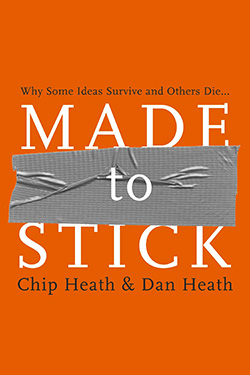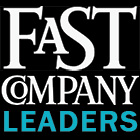What can a Kleiner Perkins VC pitch, and Hamburger Helper from General Mills, tell you about how to make your ideas tangible and real? We continue our Leadership Hall of Fame series, a year-long look at the top business books and authors, with an excerpt from Made to Stick (2007) by Fast Company columnists Dan and Chip Heath.
 For an entrepreneur, having the chance to pitch a business idea to
local venture capitalists is a big deal, like a budding actor getting an
audition with an independent film director. But having a chance to
pitch an idea to Kleiner Perkins--the most prestigious firm in Silicon
Valley--is more like a private one-on-one audition with Steven Spielberg.
You could walk out a star, or you could walk out having blown
the biggest chance of your life.
For an entrepreneur, having the chance to pitch a business idea to
local venture capitalists is a big deal, like a budding actor getting an
audition with an independent film director. But having a chance to
pitch an idea to Kleiner Perkins--the most prestigious firm in Silicon
Valley--is more like a private one-on-one audition with Steven Spielberg.
You could walk out a star, or you could walk out having blown
the biggest chance of your life.
And that's why twenty-nine-year-old Jerry Kaplan was nervous as he stood in the Kleiner Perkins office in early 1987. His presentation would start in about thirty minutes. Kaplan was a former researcher at Stanford who had quit to work at Lotus in its early days. Lotus, with its bestselling Lotus 1-2-3 spreadsheet, became a stock market darling. Now Kaplan was ready for the next challenge. He had a vision for a smaller, more portable generation of personal computers.
He hung around outside the conference room as the previous entrepreneur finished his presentation. Watching the other entrepreneur, he felt underprepared. As he observed, his nervousness advanced toward panic. The other entrepreneur wore a dark pin-striped suit with a red power tie. Kaplan had on a sport jacket with an open-collared shirt. The other entrepreneur was projecting an impressive color graph onto the whiteboard. Kaplan was carrying a maroon portfolio with a blank pad of paper inside. This did not bode well.
Kaplan had thought that he was showing up for an informal "get to know you" session, but, standing there, he realized how naive he'd been. He had "no business plan, no slides, no charts, no financial projections, no prototypes." Worst of all, the überprepared entrepreneur in the boardroom was facing a skeptical audience that now peppered him with tough questions.
When Kaplan's turn arrived, one of the partners introduced him. Kaplan took a deep breath and started: "I believe that a new type of computer, more like a notebook than a typewriter, and operated by a pen rather than a keyboard, will serve the needs of professionals like ourselves when we are away from our desks. We will use them to take notes, send and receive messages through cellular telephone links; look up addresses, phone numbers, price lists, and inventories; do spreadsheet calculations; and fill out order forms."
He covered the required technology, highlighting the major unknown: whether a machine could reliably recognize handwriting and convert it into commands. Kaplan recounts what happened next:
My audience seemed tense. I couldn't tell whether they were annoyed by my lack of preparation or merely concentrating on what I was saying. . . . Thinking I had already blown it, and therefore had little to lose, I decided to risk some theatrics. "If I were carrying a portable PC right now, you would sure as hell know it. You probably didn't realize that I am holding a model of the future of computing right here in my hands." I tossed my maroon leather case in the air. It sailed to the center of the table where it landed with a loud clap. "Gentlemen, here is a model of the next step in the computer revolution." For a moment, I thought this final act of drama might get me thrown out of the room. They were sitting in stunned silence, staring at my plain leather folder--which lay motionless on the table--as though it were suddenly going to come to life. Brook Byers, the youthful-looking but long-time partner in the firm, slowly reached out and touched the portfolio as if it were some sort of talisman. He asked the first question. "Just how much information could you store in something like this?" John Doerr [another partner] answered before I could respond. "It doesn't matter. Memory chips are getting smaller and cheaper each year and the capacity will probably double for the same size and price annually." Someone else chimed in. "But bear in mind, John, that unless you translate the handwriting efficiently, it's likely to take up a lot more room." The speaker was Vinod Khosla, the founding CEO of Sun Microsystems, who helped the partnership evaluate technology deals.Kaplan said that from that point on he hardly had to speak, as partners and associates traded questions and insights that fleshed out his proposal. Periodically, he said, someone would reach out to touch or examine his portfolio. "It had been magically transformed from a stationery- store accessory into a symbol of the future of technology."
A few days later, Kaplan got a call from Kleiner Perkins. The partners had decided to back the idea. Their investment valued Kaplan's nonexistent company at $4.5 million.
What transformed this meeting from a grill session--with an anxious entrepreneur in the hot seat--to a brainstorming session? The maroon portfolio. The portfolio presented a challenge to the boardroom participants--a way of focusing their thoughts and bringing their existing knowledge to bear. It changed their attitude from reactive and critical to active and creative.
The presence of the portfolio made it easier for the venture capitalists to brainstorm, in the same way that focusing on "white things in our refrigerator" made it easier for us to brainstorm. When they saw the size of the portfolio, it sparked certain questions: How much memory could you fit in that thing? Which PC components will shrink in the next few years, and which won't? What new technology would have to be invented to make it feasible? This same process was sparked in Sony's Japanese engineering team by the concept of a "pocketable radio."
Concreteness creates a shared "turf" on which people can collaborate. Everybody in the room feels comfortable that they're tackling the same challenge. Even experts--even the Kleiner Perkins venture capitalists, the rock stars of the technology world--benefit from concrete talk that puts them on common ground.
How do we move toward concrete ideas for our own messages? We might find our own decisions easier to make if they are guided by the needs of specific people: our readers, our students, our customers.
General Mills is one of the world's largest manufacturers of consumer products. Its brands include Pillsbury, Cheerios, Green Giant, Betty Crocker, Chex, and many others. One of the largest brands in the company, from a sales perspective, is Hamburger Helper. Melissa Studzinski, a twenty-eight-year-old from Michigan, joined General Mills in 2004 as Hamburger Helper's brand manager.
When she joined the team, Hamburger Helper had been in a decade-long slump. The CEO, frustrated by the decline, announced that his number one goal for 2005 was to fix and grow the Hamburger Helper brand. Studzinski, the newest person on the team, was eager to tackle the challenge.
When she started the job, she was given three huge binders full of data and stats: sales and volume data, advertising-strategy briefs, product information, and market research on the brand's customers. The binders were difficult to pick up, let alone absorb into memory. She called them the "death binders."
A few months later, Studzinski's team decided to put the data aside and try something new. They made plans to send members of the Hamburger Helper team--marketing, advertising, and R & D staffers --out into the homes of Hamburger Helper customers. The idea was known informally as "Fingertips," because the General Mills employees needed to have a picture of the brand's customers at their fingertips.
A call went out for mothers (the predominant customers of Hamburger Helper) who were willing to let strangers come into their homes and gawk at them while they cooked. The team visited two to three dozen homes. Studzinski visited three homes, and the experience stuck with her. "I had read and I could recite all the data about our customers," she says. "I knew their demographics by heart. But it was a very different experience to walk into a customer's home and experience a little bit of her life. I'll never forget one woman, who had a toddler on her hip while she was mixing up dinner on the stove. We know that ‘convenience' is an important attribute of our product, but it's a different thing to see the need for convenience firsthand."
Most of all, Studzinski learned that moms and their kids really valued predictability. Hamburger Helper had eleven different pasta shapes, but kids didn't care about different shapes. What they did care about was flavor, and moms just wanted to buy the same predictable flavor their kids wouldn't reject. But Hamburger Helper had more than thirty different flavors, and moms struggled to find their favorites among the massive grocery-store displays. Food and beverage companies constantly push to develop new flavors and packages, but Studzinski needed to resist this push. "Moms saw new flavors as risky," she says.
Using this concrete information about moms and kids, the team convinced a diverse collection of people across the organization--in groups ranging from supply chain and manufacturing to finance-- to simplify the product line. According to Studzinski, the cost savings were "huge," yet moms were happier because it was easier to find their families' favorites on grocery stores shelves. The insight to simplify the product line--along with other key insights concerning pricy and advertising--sparked a turnaround for the brand. At the end of fiscal year 2005, Hamburger Helper's sales had increased 11 percent.
Studzinski says, "Now when I've got a decision to make about the brand, I think of the women I met. I wonder what they would do if they were in my shoes. And it's amazing how helpful it is to think that way."
This article is excerpted from the book Made to Stick: Why Some Ideas Survive and Others Die, written by Chip and Dan Heath. Chip Heath is the Thrive Foundation of Youth Professor of Organizational Behavior in the Graduate School of Business at Stanford University, and Dan Heath is a Senior Fellow at Duke University's CASE Center, which supports social entrepreneurs. The Heath brothers' new book, Switch: How to Change Things When Change Is Hard, was released in 2010 and debuted at #1 on The New York Times bestseller list. For free resources related to both books, see heathbrothers.com.
 Follow @FastCoLeaders for all of our leadership news, expert bloggers, and book excerpts.
Follow @FastCoLeaders for all of our leadership news, expert bloggers, and book excerpts.
Read more about Made to Stick or our Leadership Hall of Fame.